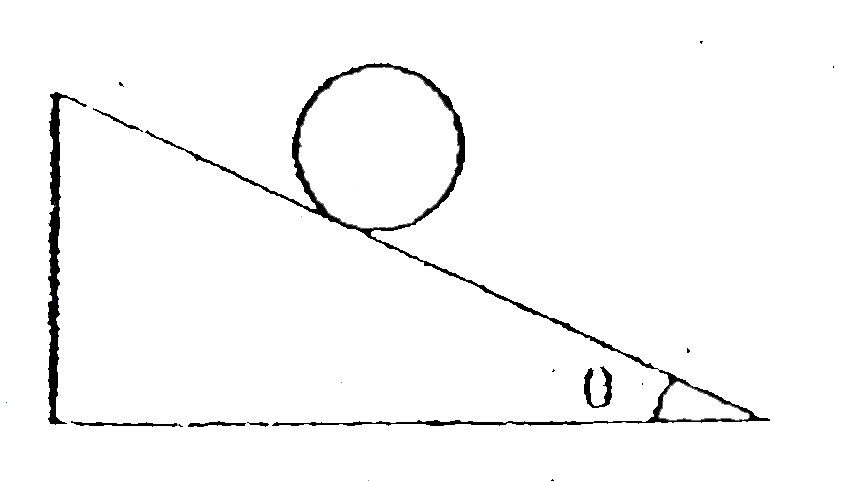A solid cylinder 30 cm in diameter at the top of an inclined plane 2.0 m high is released and rolls down the incline without loss of energy due to friction. Its linear speed at the bottom is
5.29 m/sec
4.1×103ms
51 m/s
51 cm/sec
The correct Answer is:A
To find the linear speed of a solid cylinder rolling down an inclined plane, we can use the principle of conservation of energy. Here’s a step-by-step solution:
Step 1: Identify the given data
- Diameter of the cylinder = 30 cm, hence the radius r=302=15 cm = 0.15 m
- Height of the incline h=2.0 m
- Acceleration due to gravity g=9.81 m/s²
Step 2: Write the conservation of energy equation
At the top of the incline, the cylinder has potential energy (PE) and no kinetic energy (KE) since it is at rest. At the bottom, all potential energy will have converted into kinetic energy (both translational and rotational).
The potential energy at the top is given by:
PE=mgh
The kinetic energy at the bottom is the sum of translational kinetic energy and rotational kinetic energy:
KE=12mv2+12Iω2
For a solid cylinder, the moment of inertia I is given by:
I=12mr2
And the relationship between linear speed v and angular speed ω is:
ω=vr
Step 3: Substitute the moment of inertia into the kinetic energy equation
Substituting I into the kinetic energy equation:
KE=12mv2+12(12mr2)(vr)2
=12mv2+14mv2
=34mv2
Step 4: Set potential energy equal to kinetic energy
Setting the potential energy equal to the kinetic energy:
mgh=34mv2
Step 5: Simplify the equation
Cancel m from both sides (assuming m≠0):
gh=34v2
Step 6: Solve for v2
Rearranging gives:
v2=4gh3
Step 7: Substitute the values
Substituting g=9.81 m/s² and h=2.0 m:
v2=4×9.81×2.03
=78.483=26.16
Step 8: Calculate v
Taking the square root:
v=√26.16≈5.11 m/s
Final Answer
The linear speed of the solid cylinder at the bottom of the incline is approximately 5.11 m/s.
---
- Diameter of the cylinder = 30 cm, hence the radius r=302=15 cm = 0.15 m
- Height of the incline h=2.0 m
- Acceleration due to gravity g=9.81 m/s²
At the top of the incline, the cylinder has potential energy (PE) and no kinetic energy (KE) since it is at rest. At the bottom, all potential energy will have converted into kinetic energy (both translational and rotational).
PE=mgh
KE=12mv2+12Iω2
I=12mr2
ω=vr
Substituting I into the kinetic energy equation:
KE=12mv2+12(12mr2)(vr)2
=12mv2+14mv2
=34mv2
Setting the potential energy equal to the kinetic energy:
mgh=34mv2
Cancel m from both sides (assuming m≠0):
gh=34v2
Rearranging gives:
v2=4gh3
Substituting g=9.81 m/s² and h=2.0 m:
v2=4×9.81×2.03
=78.483=26.16
Taking the square root:
v=√26.16≈5.11 m/s
The linear speed of the solid cylinder at the bottom of the incline is approximately 5.11 m/s.
Topper's Solved these Questions
- SYSTEM OF A PARTICLES & ROTATIONAL MOTIONBOOK - VMC MODULES ENGLISHCHAPTER - SYSTEM OF A PARTICLES & ROTATIONAL MOTIONEXERCISE - IN-CHAPTER EXERCISE E
10 Videos
- SIMPLE HARMONIC MOTION BOOK - VMC MODULES ENGLISHCHAPTER - SIMPLE HARMONIC MOTION EXERCISE - 7-previous year question
46 Videos
- SYSTEM OF PARTICLES AND ROTATIONAL MOTIONBOOK - VMC MODULES ENGLISHCHAPTER - SYSTEM OF PARTICLES AND ROTATIONAL MOTIONEXERCISE - IMPECCABLE
56 Videos
Similar Questions
Knowledge Check
A solid cylinder of mass M and radius R rolls down an inclined plane without slipping. THE speed of its centre of mass when it reaches the bottom is
A√(2gh)B√4/3.ghC√3/4.ghD√(4g/h)A solid cylinder of mass M and radius R rolls without slipping down an inclined plane making an angle 6 with the horizontal. Then its acceleration is.
A1/3 g sinθB2/3 g sinθC2/5 g sinθD2/7 g sinθ
A spherical object of mass m and radius R is released from the top of a smooth inclined plane of height h and angle of inclination is 37° . The radius of gyration of the object is K. The speed of object at the bottom of inclined plane is
View SolutionA hollow sphere is released from top of an inclined plane of inclination 30º and length of inclined plane is /. If sphere rolls without slipping then its speed at bottom is
View SolutionA cylinder is released from rest from the top of an incline of inclination θ and length 'L'. If the cylinder rolls without slipping. What will be its speed when it reaches the bottom?
View SolutionA solid cylinder of mass M and radius R rolls down an inclined plane of height h. The angular velocity of the cylinder when it reaches the bottom of the plane will be :
View SolutionAssertion : A solid sphere and a ring of same mass and radius are released simultaneously from the top of an inclined surface. The two objects roll down the plane without slipping. They reach the bottom of the incline with equal linear speeds
Reason : Decrease in potential enery for both is the same.
View SolutionA solid cylinder is rolling down the inclined plane without slipping. Which of the following is correct?

View Solution
